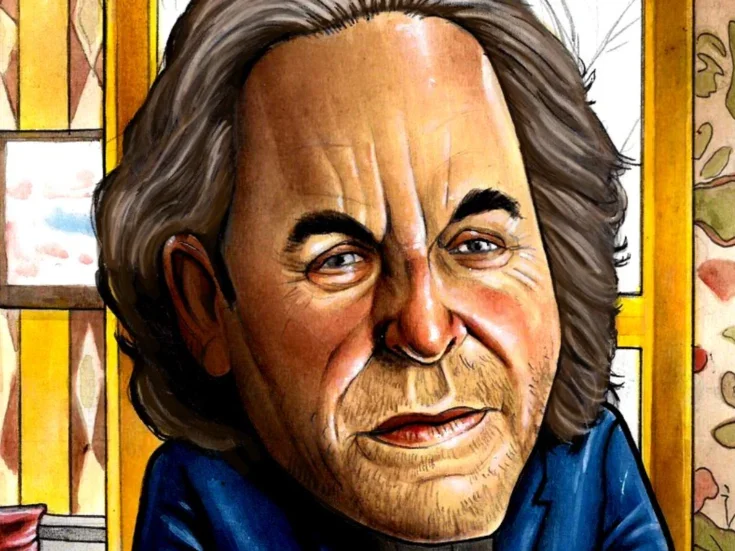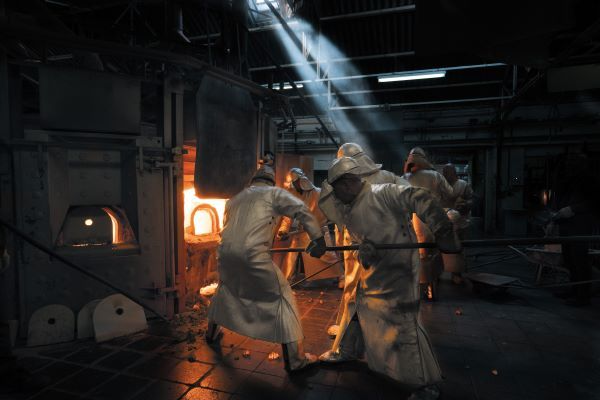
Ever since René Lalique opened his glassworks in 1922, his finely crafted creations have been hot property. Rory Sachs finds out how they plan to celebrate the centenary, and what’s in store for the next 100 years
Wingen-sur-Moder is fairly unassuming, just like the Alsatian-German speaking locals in this densely forested corner of northern France. But the village of around 1,600 people, with its colourful, sharp-roofed houses, is home to a historic hotbed of craftsmanship, which has fans around the world. It is home to the Lalique factory, which produces 400,000 pieces of crystalware each year.
Self-styled as the ‘ultimate symbol of French luxury’ and exported all over Europe, Lalique’s crystalware pieces are in high demand, with the wider business reporting revenues of more than €140 million in 2021. The factory is currently making its way through a months-long list of orders for its intricate hand-made creations.
The pieces are formed with the help of 1,400°C furnaces that are always ablaze, save for occasional 30-minute cool-downs and thorough inspections and re-engineering, which takes place every seven years or so. Inside, the average piece is prepared and crafted by 26 workers who spend a cumulative 30 hours turning raw materials from a lead-rich chemical pottage into refined artefacts that are inspected for any slight imperfections.
Once acid-bathed, burnished and drilled with nanoscopic precision, each piece of crystal is permitted to carry the surname of René Lalique, who lit the first furnaces here in the autumn of 1922, almost exactly 100 years ago. He maintained his own exacting standards.
‘Without the factory, we would be no one, nothing,’ says Frederick Fischer, Lalique’s managing director in the UK, reflecting on the celebrations of the factory’s centenary. ‘It’s a big celebration – a big step… because we started in 1888 as jewellers, and then we became, by accident, glassmakers.’
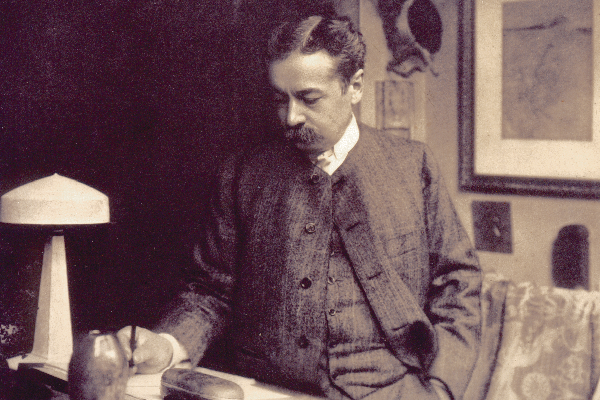
As a jeweller in Paris, Lalique, who was born in 1860, cut his teeth under the tutelage of goldsmith Louis Aucoc while taking lessons at the city’s École des Arts Décoratifs. It was not long before Lalique’s pieces were widely lauded; at the start of the 20th century he earned the exalted rank of Officier de la Légion d’Honneur. He came to be known as the ‘inventor of modern jewellery’.
Yet the one-time Cartier designer also developed a reputation for his perfume bottles, and in 1909 he rented a glassmaking house in Combs-la-Ville, a Parisian suburb. In 1911 he created an exhibition entirely devoted to glassware. ‘He started to do vases, figurines, chandeliers,’ Fischer says. ‘It was the end of art nouveau, the beginning of art deco in 1922, and the House of Lalique became popular as [a] glass-maker.’
In his introduction to a design catalogue for the International Exhibition of Modern Decorative and Industrial Arts in 1925, Lalique wrote that glass was ‘a material which lends itself to an almost infinite number of utilitarian and ornamental combinations’, before praising industry peers: ‘It is you who should receive the glory of having promoted and generalised its use for the greater good.’
Glass became a way for Lalique to reconcile the forces of art and industry while democratising beauty. ‘He was a very clever businessman,’ says Anne-Céline Desaleux, associate director of the Musée Lalique, which opened near the factory in 2011 to memorialise works from across the designer’s lifetime. ‘He also knew how to find people who were skilled to work with him.’
In search of more factory space, he was directed to Wingen-sur-Moder in 1919 after France regained control of Alsace at the end of the First World War – with the help of Alexandre Millerand, an early devotee of Lalique’s designs who later became the French president.
Production began at the site in 1922, when Lalique was 62. ‘Alsace is renowned for glassmaking,’ says Fischer, who hails from the region himself. ‘Often we have families, from the grandfather, father and son, working at the factory in the village. We’re celebrating the factory itself, but also all of the people who’ve worked for the factory.’
How is Lalique crystal made?
In the parched heat of the factory’s hot-glass workshop, a Lalique technician removes molten crystal from one of the 12 clay kilns in the furnace with a large pole. Clay makers spend three weeks casting these little ovens, which have a lifespan of four months before they are replaced due to wear, in a procedure known as ‘the changing of the pot’, where hazmat-suited men gouge out the clay from the furnace (pictured at the top of the article).
‘You are lucky, because we have one of the smallest items at the same time as one of the biggest vases,’ Frédéric Bour, who works in product development, tells me as he shows me around the factory. We are watching as Languedoc vases are prepared: only three of these can be made in an hour, but the factory is also producing fragments of crystal for rings, producing up to 60 tiny shards in that same timeframe.

My visit coincides with filming for the France 3 television station; the network’s cameramen are transfixed on the action, standing just metres away from the 1,000°C plume of molten crystal that hangs from a metal pole wielded by one of the craftspeople. Following Lalique’s death in 1945, his son Marc took over the family business and began to focus entirely on the luxury market. Since the 1950s, these furnaces have only produced crystalware.
The craftsperson quickly puts the molten substance into an iron mould, of which there are around 6,000 in the workshop’s inventory. There, the mixture cools from around 1,400°C to around 800°C, before being placed in sand to prevent cracking as it solidifies.
Hardened, cooled and removed from the iron casts, Lalique’s fineries undergo laborious quality checks. Blemishes and imperfections are highlighted with a marker pen, while delicate carvings are covered in a protective plaster material before intensive acid-bathing. ‘Our competitors are not so crazy as we are,’ Bour says.
He adds that ‘no computer, no machine’ could rival the intricate detail of a piece made by hand. It takes a while for craftspeople to acquire the necessary dexterity, and there are often long time lags when training new workers. ‘You have to be very handy,’ Desaleux laughs. ‘You work a lot with your hands, and have to be very precise, and be able to make things over and over again’.
As with his jewellery, Lalique’s primary inspirations for his glassware were his beloved ‘three Fs’: fauna, flora and the female form. ‘We have a lot of the dragonflies, butterflies, snakes… and even bats,’ says Desaleux of the artefacts she’s seen as part of her archival work for Musée Lalique. Over the past decade, 650 pieces of glassware and jewellery have been amassed, some on loan from collectors and Lalique itself, which the museum otherwise wouldn’t be able to afford.
It seems inevitable, Desaleux says, that the surrounding nature of the Northern Vosges influenced the factory’s early designs. Creations from the 21st century also pay homage to these inspirations – a sculpture of a toad has been delicately embellished with golden bubbles, while the white-and-golden vase is lined with gilded leaves and emulates one of Lalique’s 1939 designs, itself borrowing inspiration from the Medici Vase, made in Athens in the 1st century. The Angélique vase, shown above in ‘ultramarine’ blue, is a powerful ‘hymn of praise to nature and femininity’, according to the brand.
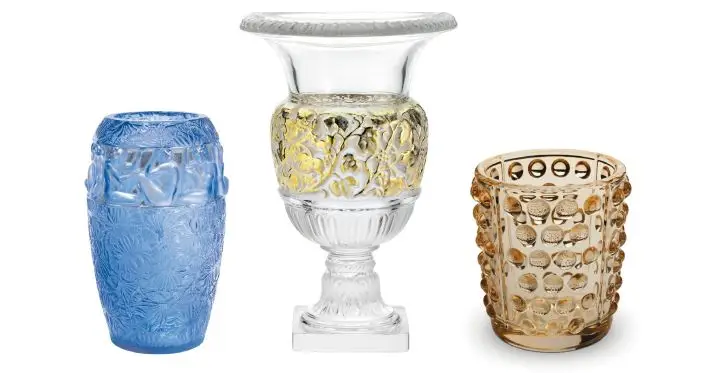
Although faithful to the ‘three Fs’, today’s designers are breathing new life into the brand, modernising traditional designs with new colours and patterns. For 2022, Lalique has launched a collection of cerulean blue designs, updating several of Lalique’s signatures from the factory’s early years – a Tourbillons vase and a Languedoc vase from 1926, as well as a Bacchantes from 1927, which featured several depictions of European women.
Rethinking the design for a modern age, the new azure Bacchantes, which was first unveiled by Lalique 95 years ago, features more diversity, says Fischer. ‘We did ask [photographer] Terry Rodgers to do a new version, so the girls are from all over the world,’ Fischer says. ‘Each piece has only one mould, and we did eight pieces… They are all unique.’
To mark the centenary, the factory is also producing a rare collection of 10 signed ‘Flacon Fusion’ perfume bottles, priced at €21,500. They carry patterns representing a fern – one of René Lalique’s favourite plants, and essential to the manufacturing process: fern potash gives the crystal structure density and is used to lower its melting point.
***
Swiss entrepreneur Silvio Denz acquired Lalique in 2008 with a plan to modernise the business, and opened up Villa René Lalique in 2015. What was once Lalique’s private residence near the factory in Wingen-sur-Moder has been refurbished and reimagined as a six-bedroom luxury getaway.
The hotel features a two-Michelin-starred restaurant where Austrian chef Paul Stradner serves up dishes inspired by Lalique’s heritage. Diners, meanwhile, can look through panoramic windows at the surrounding garden’s towering trees – just as Lalique would have done in the 1920s – and watch as nightfall approaches and the crystal and glassware throughout the room refract a lower, subdued light.
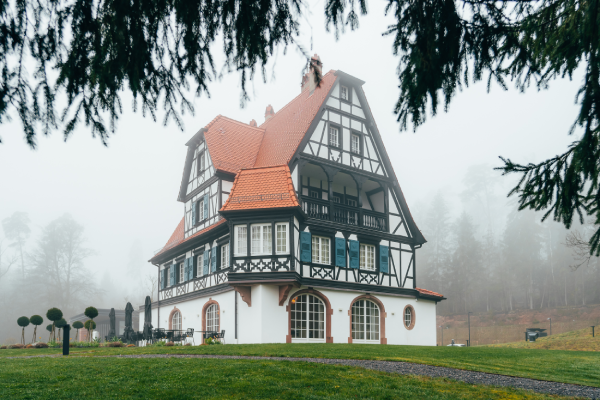
For UK-based customers, a stay might even provide inspiration for a trip back to the brand’s store in London’s Burlington Arcade. Elsewhere, Lalique super-fans might also like to explore Hôtel & Restaurant Lalique in Bordeaux and visit Scotland’s Glenturret distillery for lunch, which was opened in 2021 after Lalique acquired a 50 per cent stake in the whisky-maker in 2019.
Lalique arrived in the UK in 1938 with its first concession outside France. ‘You know that British men love three things mostly – firstly their dog, secondly their car and thirdly their wife,’ Fischer laughs. ‘For the car to be personalised, you could put a mascot on the bonnet of the car and René Lalique did 28 of them in glass, and it became very, very fashionable. Everybody wanted to have a Lalique mascot on their cars.’
Fischer finds that British consumer tastes remain conservative: ‘Some of them, they keep their car for 30, 40 years. And when they’ve decided that they like a brand, like Lalique, they go for it. They still come back, and it’s amazing for us.’
Yet new customers are discovering the brand all the time, to Fischer’s delight. He tells the story of an Essex couple who came to Lalique after seeing its lamps and wall lights decorating a room in Claridge’s where they had been staying. ‘They spent £6,000 with us. We have clients that are spending much more… but £6,000 is a nice sale,’ Fischer says. As the Lalique factory turns 100, it’s not only the furnaces that are shining brightly.
Image: Sequences Studio



